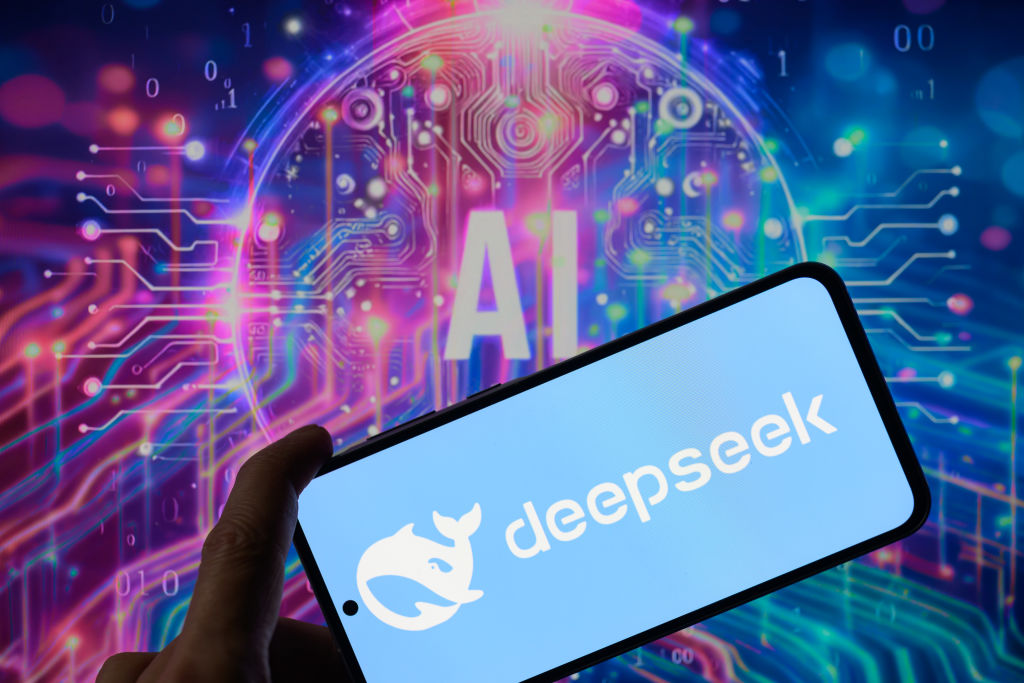The DeepSeek Crash: What It Means for AI Investors
DeepSeek's R1 model represents both risk and opportunity. Here's what DeepSeek means for AI investors.


Training a foundation model like those advanced artificial intelligence systems from OpenAI and Anthropic requires enormous amounts of data, the use of expensive GPUs and sophisticated fine tuning.
It's a process that can take months and hundreds of millions of dollars – or so it was thought until a tech startup from China upended this conventional approach.
In late January, DeepSeek claimed that it built its own foundation model for less than $6 million. The response from investors to this news was brutal and swift.
From just $107.88 $24.99 for Kiplinger Personal Finance
Become a smarter, better informed investor. Subscribe from just $107.88 $24.99, plus get up to 4 Special Issues

Sign up for Kiplinger’s Free Newsletters
Profit and prosper with the best of expert advice on investing, taxes, retirement, personal finance and more - straight to your e-mail.
Profit and prosper with the best of expert advice - straight to your e-mail.
The price of Nvidia (NVDA) stock plunged 17% on January 27, wiping out $590 billion in value. It was the largest drop in market capitalization for a company in a single day. Many other semiconductor and AI companies sold off amid a $1 trillion evaporation of wealth.
This may be an overreaction. AI stocks have been on a major bull run for the past couple of years, and valuations certainly have reached lofty levels.
But there are real signs the AI market is undergoing fundamental changes. Here's what DeepSeek means for AI investors.
What is DeepSeek?
The founder of DeepSeek, 40-year-old Liang Wenfeng, is a billionaire who made his wealth as a hedge fund manager. A key part of his approach has been to leverage AI for his investment strategies.
A few years ago, Wenfeng started buying up thousands of GPUs from Nvidia. He did this ahead of impending import restrictions on this technology from the U.S.
It's not clear if Wenfeng was able to obtain more high-powered GPUs. If not, his AI team was able to use innovative techniques to more efficiently train their models.
One of these is "distillation," which involves using larger modes to improve the performance of smaller models. Another approach is "mixture of experts," or training different parts of a model for specific tasks.
DeepSeek's latest foundation model is called R1, which is open source. This means the code and weights for the model are freely available (although the underlying training data has not been disclosed).
Based on a variety of tests, the R1 model has been shown to be on par or even better than other models from OpenAI, Anthropic, and Facebook and Instagram parent Meta Platforms (META).
As Andreessen Horowitz cofounder Marc Andreessen said in a tweet shortly after the results of its test were made public, "Deepseek R1 is one of the most amazing and impressive breakthroughs I’ve ever seen — and as open source, a profound gift to the world."
The immediate impact of DeepSeek
It's still early days for the R1 model. In the coming weeks, more details on its performance will emerge. It helps that the model is open source, which makes it easier for outsiders to conduct independent analysis.
There are big questions about the true costs of the system as well as how the model was trained. It may be that DeepSeek made extensive use of OpenAI for the process.
"It isn't clear yet if DeepSeek is the real deal or a DeepFake, but regardless of what we learn in the coming days, it's clear that this is a wake up call," said Dr. Robert Blumofe, the chief technology officer of Akamai Technologies (AKAM).
According to Blumofe, "The path of bigger and bigger large language models that rely on ever-increasing GPUs and massive amounts of energy is not the only path forward."
Even before the launch of R1, there were signs of commoditization for foundation models. The market has been intensely competitive, and pricing has been falling significantly.
This is not good news for those companies that rely mostly on these systems like OpenAI and Anthropic, which command substantial valuations.
In fact, economics of the recently announced $500 billion Stargate project involving Oracle (ORCL), OpenAI, SoftBank and technology investment firm MGX already look dicey.
Nvidia could also face additional pressure and not just from upstarts like DeepSeek.
Nvidia's biggest customers – including Amazon.com (AMZN), Microsoft (MSFT), Google parent Alphabet (GOOGL) and Meta – are building their own chipsets.
The potential upside of DeepSeek
If DeepSeek's innovations prove to be real, there should be considerable benefits as well.
"The new-found AI competition could lead to breakthroughs in the compute resources needed to power AI workloads," said Lisa Martin, a research director at The Futurum Group.
Lower costs will help to make powerful AI technologies more pervasive, making it easier, for example, for software developers like ServiceNow (NOW) and Salesforce (CMS) to build their applications.
"The focus is shifting from innovation in the model itself to how effectively it can be deployed," said Qlik CEO Mike Capone.
Capone says the real winners of the AI race will be "companies that understand this pivot."
"The future isn't about chasing the next slightly better model," he explains. "It's about building the infrastructure to operationalize AI, leveraging proprietary data, and ensuring outputs reach the people who can act on them."
Related content
- Four Ways to Invest in Quantum Computing
- The Best Lithium Stocks to Buy Now
- Hot Upcoming IPOs to Watch
Profit and prosper with the best of Kiplinger's advice on investing, taxes, retirement, personal finance and much more. Delivered daily. Enter your email in the box and click Sign Me Up.

Tom Taulli has been developing software since the 1980s when he was in high school. He sold his applications to a variety of publications. In college, he started his first company, which focused on the development of e-learning systems. He would go on to create other companies as well, including Hypermart.net that was sold to InfoSpace in 1996. Along the way, Tom has written columns for online publications such as Bloomberg, Forbes, Barron's and Kiplinger. He has also written a variety of books, including Artificial Intelligence Basics: A Non-Technical Introduction. He can be reached on Twitter at @ttaulli.
-
 I'm want to give my 3 grandkids $5K each for Christmas.
I'm want to give my 3 grandkids $5K each for Christmas.You're comfortably retired and want to give your grandkids a big Christmas check, but their parents are worried they might spend it all. We ask the pros for help.
-
 If You're Not Doing Roth Conversions, You Need to Read This
If You're Not Doing Roth Conversions, You Need to Read ThisRoth conversions and other Roth strategies can be complex, but don't dismiss these tax planning tools outright. They could really work for you and your heirs.
-
 Could Traditional Retirement Expectations Be Killing Us?
Could Traditional Retirement Expectations Be Killing Us?A retirement psychologist makes the case: A fulfilling retirement begins with a blueprint for living, rather than simply the accumulation of a large nest egg.
-
 I'm a Financial Planner: If You're Not Doing Roth Conversions, You Need to Read This
I'm a Financial Planner: If You're Not Doing Roth Conversions, You Need to Read ThisRoth conversions and other Roth strategies can be complex, but don't dismiss these tax planning tools outright. They could really work for you and your heirs.
-
 Could Traditional Retirement Expectations Be Killing Us? A Retirement Psychologist Makes the Case
Could Traditional Retirement Expectations Be Killing Us? A Retirement Psychologist Makes the CaseA retirement psychologist makes the case: A fulfilling retirement begins with a blueprint for living, rather than simply the accumulation of a large nest egg.
-
 I'm a Financial Adviser: This Is How You Can Adapt to Social Security Uncertainty
I'm a Financial Adviser: This Is How You Can Adapt to Social Security UncertaintyRather than letting the unknowns make you anxious, focus on building a flexible income strategy that can adapt to possible future Social Security changes.
-
 I'm a Financial Planner for Millionaires: Here's How to Give Your Kids Cash Gifts Without Triggering IRS Paperwork
I'm a Financial Planner for Millionaires: Here's How to Give Your Kids Cash Gifts Without Triggering IRS PaperworkMost people can gift large sums without paying tax or filing a return, especially by structuring gifts across two tax years or splitting gifts with a spouse.
-
 'Boomer Candy' Investments Might Seem Sweet, But They Can Have a Sour Aftertaste
'Boomer Candy' Investments Might Seem Sweet, But They Can Have a Sour AftertasteProducts such as index annuities, structured notes and buffered ETFs might seem appealing, but sometimes they can rob you of flexibility and trap your capital.
-
 AI Stocks Lead Nasdaq's 398-Point Nosedive: Stock Market Today
AI Stocks Lead Nasdaq's 398-Point Nosedive: Stock Market TodayThe major stock market indexes do not yet reflect the bullish tendencies of sector rotation and broadening participation.
-
 Got $100 to Gamble? These Penny Stocks Could Be Worth the Ride
Got $100 to Gamble? These Penny Stocks Could Be Worth the RideVolatile penny stocks are high-risk plays with potentially high rewards. If you have $100 you can afford to lose, these three names are worth a look.
-
 Quick Question: Are You Planning for a 20-Year Retirement or a 30-Year Retirement?
Quick Question: Are You Planning for a 20-Year Retirement or a 30-Year Retirement?You probably should be planning for a much longer retirement than you are. To avoid running out of retirement savings, you really need to make a plan.